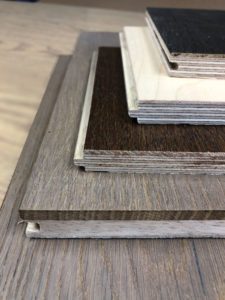Measuring Materials other than Wood
 Each moisture meter from Lignomat (pin or pinless) is set-up to measure moisture in wood, which is easy and straight forward: You look up the wood species on the wood group card which comes with each meter, set the number and you are ready to measure the moisture content in percent. If the wood species is not listed, call Lignomat at 800-227-2105 for information about the correct setting.
Each moisture meter from Lignomat (pin or pinless) is set-up to measure moisture in wood, which is easy and straight forward: You look up the wood species on the wood group card which comes with each meter, set the number and you are ready to measure the moisture content in percent. If the wood species is not listed, call Lignomat at 800-227-2105 for information about the correct setting.
Some meters from Lignomat have special calibrations for materials other than wood. For instance, plywood, OSB, Advantech, bamboo, different, interior and exterior wall panels and standard sheetrock.
Even if the material you want to measure is not listed, you can still find valuable information about moisture conditions, when using one of Lignomat’s meters with comparative or reference scales.
- When a dry sample with a known moisture content is available
- When a dry sample is available
- When no dry sample is available
When a dry sample with a known moisture content is available:
Pinless: First, measure the dry sample with the meter on setting #50. If value indicated is higher (lower) than the moisture content of the known sample, increase (decrease) setting until meter indicates same moisture content.
Pin: The method described for pinless does not work for pin, because there is no linear relation between wood species settings. Please, contact Lignomat at 800-227-2105.
If you have a sample that is well acclimated to a stable relative humidity, you can find the moisture content using the EMC chart. Example: if your show room is well acclimated to 45% relative humidity, all materials eventually have an 8.5% WME comparable to 8.5% wood moisture.
When a dry sample is available: First, measure a dry sample with the reference scale and note the value. Keep in mind, that the number is not a moisture percentage. Take more measurements and compare to the dry sample value. Higher values always mean more moisture. For water damaged areas, try and find an unaffected area to establish a base value.
No dry sample: Even if no dry sample is available, taking two or more measurements with a reference scales will indicate, if the moisture levels are the same or different. Higher values always indicate more moisture. Taking many measurements is a good way to find problem areas where too much moisture is present. Even if your meter does not have a reference scale, you can dedicate a wood group setting on the meter and use the same setting for comparative measurements.
Measuring multi-layered materials in the building and flooring industry. The methods described above can also be applied to measure and compare multi-layered materials. Values can only be compared when the thickness and the composition of the materials is the same.
Lignomat offers to test engineered products to determine a setting for Lignomat meters to obtain WME moisture percentages (percentages which can be compared to wood moisture percentages). For instance, if our meters indicate 8.5% for an engineered product, the product is stable in a 45% relative humidity environment just as if it was wood at 8.5%. (See EMC chart)

